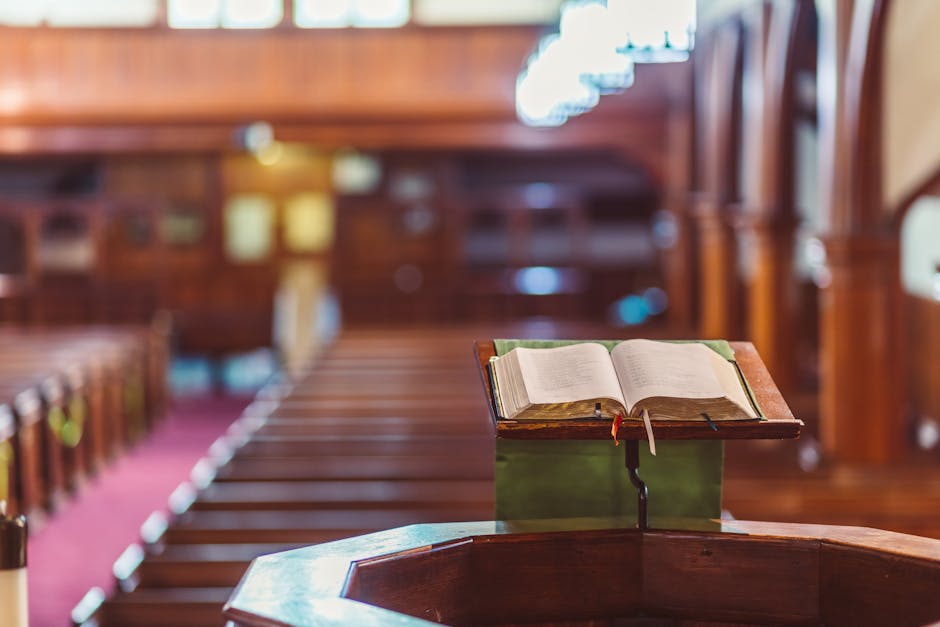Introduction
Symbols in Catholicism are powerful tools that bring the faith to life. They help believers connect with deeper truths and feel the presence of the divine in everyday life.
These symbols are woven into the fabric of Catholic worship and devotion, making the spiritual more tangible and accessible.
The richness and variety of Catholic symbols are truly remarkable. From the familiar sight of the Cross to the gentle image of the Virgin Mary, each symbol carries its own special meaning.
They remind us of the love, sacrifice, and hope that are at the heart of the Catholic faith.
These symbols aren’t just decorations; they are ways to feel closer to God, to remember important teachings, and to inspire prayer and reflection.
Whether in a church, a home, or worn as a piece of jewelry, Catholic symbols touch our hearts and souls. They guide us, comfort us, and help us to live our faith more fully.
As St. Augustine beautifully said, “Faith is to believe what you do not see; the reward of this faith is to see what you believe.”
Catholic Symbols and Catholic Church Symbols
1. The Cross and Crucifix
The Cross and Crucifix are the most iconic symbols of the Christian faith.
The Cross, usually depicted as an empty cross, symbolizes the resurrection of Jesus and the hope of eternal life.
The Crucifix, which shows Jesus’s body on the cross, represents his ultimate sacrifice and profound love for humanity.




The significance of these symbols cannot be overstated. They remind us of the central story of Christianity: Jesus’s death and resurrection.
This powerful image calls us to remember His suffering and the immense love He showed by dying for our sins.
You’ll find the Cross and Crucifix everywhere in Catholic life. They are prominently displayed in churches, often placed at the center of the altar.
Many Catholics also keep them in their homes as a constant reminder of their faith. Additionally, these symbols are worn as jewelry, serving as personal tokens of devotion and faith.
Most crosses are worn around the neck, keeping God close to your heart, symbolizing His constant presence and love.
Crosses are usually placed in prominent positions, often above and facing downwards. In churches, the Crucifix is typically hung above the altar, looking down over the congregation.
This placement symbolizes Christ watching over His people and blessing them from above. It serves as a powerful visual reminder of His presence and His sacrifice, encouraging the faithful to reflect on their own lives and faith.
In every setting, the Cross and Crucifix inspire reflection, prayer, and gratitude.
They are enduring symbols of faith, hope, and love, reminding us of the profound impact of Jesus’s sacrifice.
As St. Paul said, “But God shows His love for us in that while we were still sinners, Christ died for us” (Romans 5:8).
2. The Sacred Heart
The Sacred Heart is one of the most beloved symbols in Catholicism, depicting the heart of Jesus Christ surrounded by a crown of thorns and emitting rays of light. This powerful image represents Jesus’s divine love for humanity, his suffering for our sins, and his compassionate heart that is always open to us.

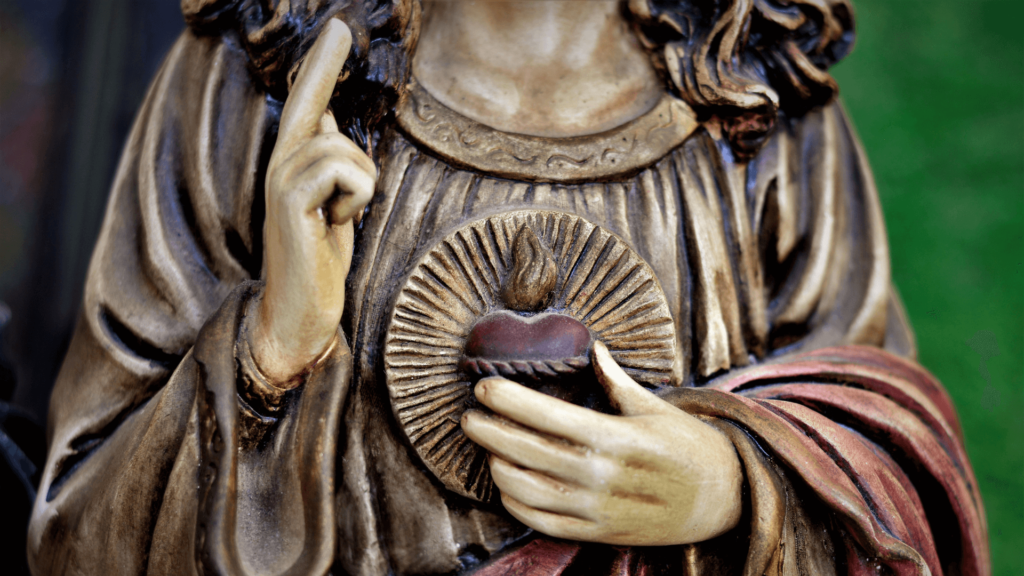


Profound Message of Love and Mercy
The significance of the Sacred Heart lies in its profound message of love and mercy.
It calls us to reflect on the immense love Jesus has for each one of us and His willingness to endure pain and sacrifice for our salvation.
The Sacred Heart is a reminder of His boundless compassion and the promise of His eternal love.
Prominence in Worship and Devotion
The Sacred Heart is prominently featured in Catholic worship and devotion.
You’ll find images and statues of the Sacred Heart in many churches, often placed in a prominent location where the faithful can offer their prayers and devotion.
Many Catholics also have images of the Sacred Heart in their homes, serving as a constant reminder of Jesus’s love and mercy.
Devotional Practices
Devotional practices, such as the First Fridays devotion, are centered around the Sacred Heart, inviting believers to seek Jesus’s love and atonement.
Personal Devotion
In personal devotion, the image of the Sacred Heart is often worn as jewelry, particularly in necklaces and medals. Wearing the Sacred Heart close to one’s own heart symbolizes keeping Jesus’s love and compassion close in daily life.
Inspiration to Live with Love and Compassion
The Sacred Heart inspires us to live with greater love, mercy, and compassion in our own lives, following the example of Jesus.
As St. John Vianney said, “The heart of man is the masterpiece of creation, made in the image of God.“
In every setting, the Sacred Heart encourages reflection, prayer, and a deeper connection with Jesus’s divine love, reminding us of the profound impact of His sacrifice and His promise of eternal love and mercy.
3. The Virgin Mary
A Cherished Presence in Catholic Faith
The Virgin Mary holds a unique and cherished place in the Catholic faith.
Often depicted in serene and graceful imagery, Mary is typically shown with a blue mantle, symbolizing her purity and heavenly nature.
As the mother of Jesus, she is venerated as the Mother of God and the Queen of Heaven.




Embodying Virtues of Faith and Love
Mary’s role in Catholicism is both profound and inspirational.
Her unwavering “yes” to God’s plan at the Annunciation brought forth the Savior, making her an essential figure in the narrative of salvation.
She embodies the virtues of faith, humility, and unconditional love, serving as a model for all believers.
Devotion in Everyday Life
Devotion to Mary permeates every aspect of Catholic life. In churches, she is honored with statues and icons, often found in dedicated chapels or altars where the faithful come to pray and seek her intercession.
Many Catholics also keep images or statues of Mary in their homes, creating personal spaces for prayer and reflection.
The Rosary, a cherished devotion, invites believers to meditate on the life of Christ and seek Mary’s intercession.
Celebrations and Pilgrimages
Marian feast days, such as the Immaculate Conception and the Assumption, are celebrated with deep reverence, highlighting her significance in the liturgical calendar.
Pilgrimages to Marian shrines like Lourdes and Fatima attract millions of faithful each year, all seeking her guidance and miraculous intercession.
Personal Devotion and Protection
Personal devotion to Mary is also expressed through wearing medals or scapulars bearing her image, which serve as reminders of her maternal protection and care.
These devotional items help Catholics keep Mary’s presence close in their daily lives, offering comfort and strength.
A Beacon of Hope and Peace
The Virgin Mary stands as a beacon of hope, compassion, and peace.
Her example inspires the faithful to trust in God’s will and to live lives of service and love.
As St. Maximilian Kolbe said, “Never be afraid of loving the Blessed Virgin too much. You can never love her more than Jesus did.“
Conclusion
Through Mary, Catholics find a source of unwavering support and a reminder of the power of a loving, humble heart dedicated to God’s service.
Her influence in the Church is a testament to her pivotal role in the story of salvation and the spiritual lives of the faithful.
4. The Rosary
A Beloved Devotional Practice
The Rosary is one of the most cherished devotional practices in Catholicism. It consists of a string of beads used for counting prayers, each bead representing a specific prayer in a sequence of meditations.




Meditative and Reflective Prayer
The Rosary invites believers to meditate on the life of Christ and the intercessions of the Virgin Mary.
Through the recitation of prayers, such as the Hail Mary, Our Father, and Glory Be, Catholics reflect on the joyful, sorrowful, glorious, and luminous mysteries of the faith.
Structure and Use
The structure of the Rosary includes five decades, each consisting of one Our Father, ten Hail Marys, and one Glory Be.
This sequence is repeated while meditating on different mysteries of the life of Jesus and Mary.
Personal and Communal Devotion
The Rosary is used in both personal and communal devotion. Many Catholics pray the Rosary daily, often finding peace and solace in the rhythmic repetition of prayers.
It is also a common practice to pray the Rosary in groups, such as during church gatherings, family prayer times, and Rosary circles.
Spiritual Benefits
Praying the Rosary offers numerous spiritual benefits. It helps believers grow in their relationship with Jesus and Mary, fosters a deeper understanding of the Gospel, and provides a structured way to contemplate the mysteries of the faith.
The Rosary also serves as a powerful tool for intercession, allowing Catholics to pray for their needs and the needs of others.
A Source of Comfort and Strength
The Rosary has been a source of comfort and strength for Catholics throughout history.
In times of crisis, illness, or personal difficulty, many turn to the Rosary as a way to seek divine help and guidance.
The repeated prayers and meditations provide a sense of stability and hope.
Conclusion
As St. John Paul II said, “The Rosary is my favorite prayer. A marvelous prayer! Marvelous in its simplicity and its depth.”
The Rosary continues to be a beloved and enduring practice that enriches the spiritual lives of countless Catholics around the world.
5. The Chi-Rho
An Early Christian Symbol
The Chi-Rho is one of the earliest symbols used by Christians, consisting of the first two letters of the Greek word for Christ, ΧΡΙΣΤΟΣ.
This monogram combines the letters Chi (Χ) and Rho (Ρ), creating a symbol that represents Jesus Christ.

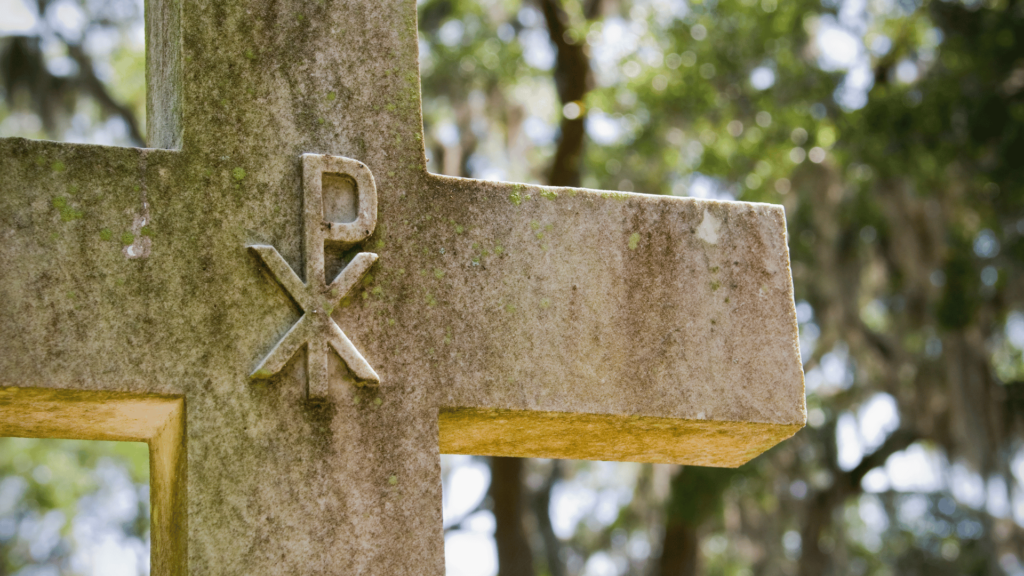

Significance and Meaning
The Chi-Rho holds profound significance as a symbol of Christ and Christianity. It serves as a reminder of Jesus’s presence and His role as the Messiah.
The symbol is a testament to the early Christian community’s faith and their recognition of Jesus as the Savior.
Use in Christian Art and Architecture
The Chi-Rho is commonly found in Christian art and architecture. It has been used in various forms of religious decoration, including mosaics, paintings, and sculptures.
In early Christian churches, the Chi-Rho often adorned altars, walls, and ceilings, symbolizing Christ’s central role in the faith.
Historical Importance
Historically, the Chi-Rho gained prominence when Emperor Constantine adopted it as a symbol for his army.
According to tradition, Constantine saw a vision of the Chi-Rho before the Battle of the Milvian Bridge, accompanied by the words, “In this sign, you will conquer.”
After his victory, Constantine legalized Christianity and used the Chi-Rho on his army’s standards and shields, marking a significant moment in Christian history.
A Symbol of Victory and Hope
The Chi-Rho is not only a symbol of Christ but also of victory and hope.
It represents the triumph of Jesus over sin and death, offering believers a powerful reminder of His promise of eternal life.
This symbol continues to inspire Christians to live with courage and faith, trusting in the ultimate victory of Christ.
Conclusion
The Chi-Rho remains a cherished symbol in Christianity, reflecting the faith and devotion of the early Christians and their unwavering belief in Jesus as the Christ. As St. Paul wrote, “For to me, to live is Christ and to die is gain” (Philippians 1:21).
The Chi-Rho stands as a testament to this profound truth and continues to be a source of inspiration and hope for Christians today.
6. The Ichthys (Fish)
An Ancient Christian Symbol
The Ichthys, also known as the Fish, is an ancient Christian symbol that has deep roots in early Christian history.
The symbol consists of two intersecting arcs that resemble the profile of a fish. Often, the Greek letters ΙΧΘΥΣ (Ichthys) are written inside the fish shape.

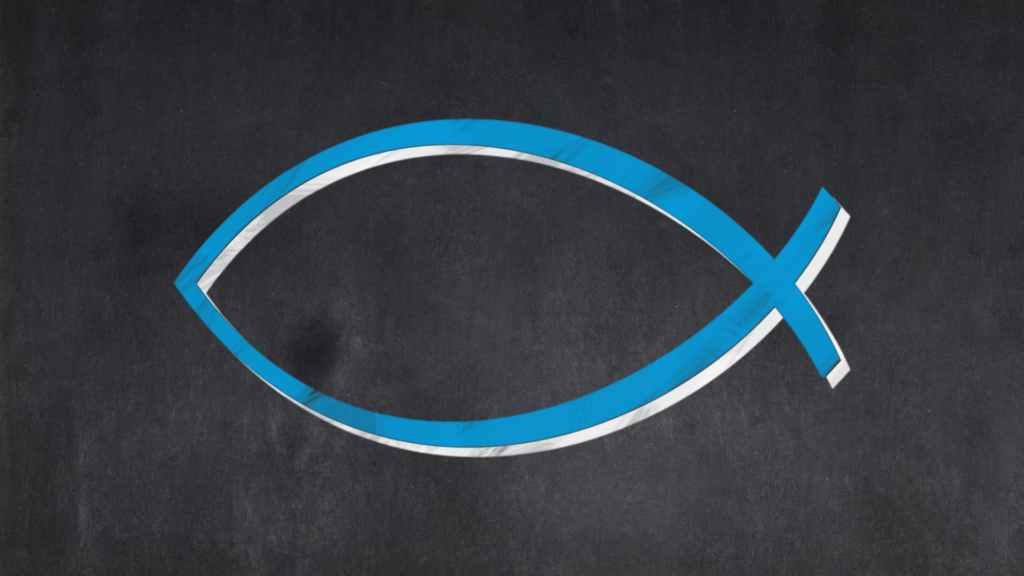
Meaning and Significance
The Greek word ΙΧΘΥΣ stands for “Jesus Christ, Son of God, Savior.” Each letter represents the first letter of the Greek words Iesous Christos Theou Yios Soter.
This acronym encapsulates the core beliefs of Christianity, making the Ichthys a powerful declaration of faith.
Use in Early Christianity
In the early days of Christianity, the Ichthys was used as a secret symbol among believers.
During times of persecution, Christians used the fish symbol to identify themselves to one another and to mark safe meeting places.
This simple yet profound symbol provided a way for early Christians to express their faith covertly.
Symbol of Faith and Baptism
The Ichthys also holds significance as a symbol of faith and baptism.
The fish is associated with water, which is central to the sacrament of baptism.
This connection reinforces the idea of spiritual rebirth and purification through Christ.
Modern Usage
Today, the Ichthys continues to be a widely recognized symbol of Christianity.
It can be seen on car decals, jewelry, and various religious items.
The symbol serves as a public expression of one’s faith and a reminder of the early Christians’ resilience and devotion.
Conclusion
The Ichthys remains a timeless symbol that conveys the essence of Christian belief: the acknowledgment of Jesus Christ as the Son of God and the Savior of humanity.
As Jesus said, “Follow me, and I will make you fishers of men” (Matthew 4:19).
The Ichthys encapsulates this call to discipleship and continues to inspire Christians to live out their faith with courage and conviction.
7. The Alpha and Omega
The Eternal Symbol
The Alpha and Omega are the first and last letters of the Greek alphabet, representing the concept of eternity and the encompassing nature of God.
This symbol is deeply rooted in Christian theology, where God is described as the beginning and the end of all things.


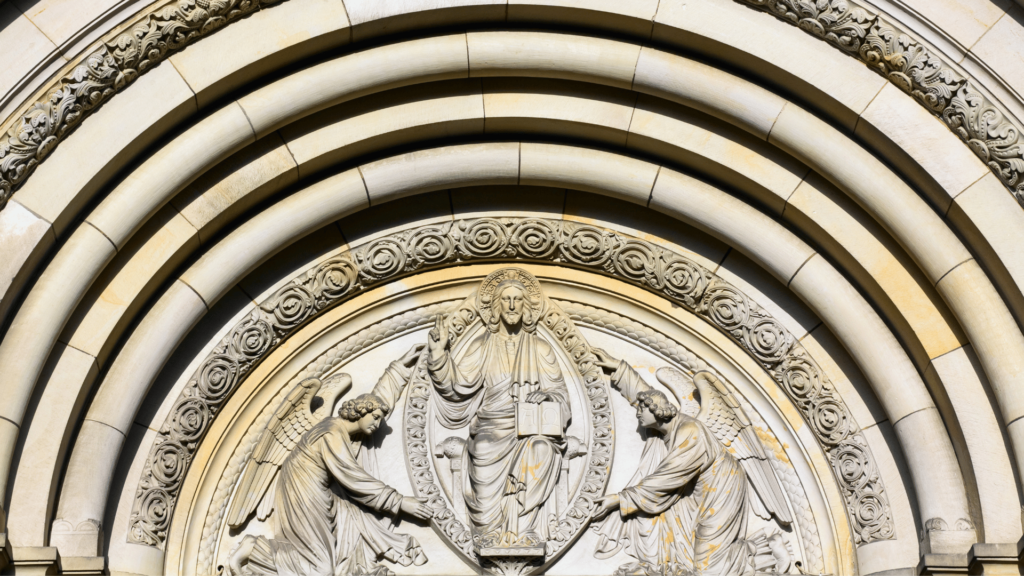

Significance in Scripture
The use of Alpha and Omega is prominently found in the Book of Revelation. In Revelation 22:13, Jesus declares, “I am the Alpha and the Omega, the First and the Last, the Beginning and the End.”
This proclamation underscores the eternal nature of Christ, affirming His divine omnipotence and eternal existence.
Theological Implications
The Alpha and Omega symbolize the infinite nature of God.
They remind believers that God’s presence transcends time and space.
God exists beyond the confines of the beginning and the end as we understand them.
This symbol assures Christians of God’s constant presence and His ultimate control over the universe.
Philosophical Depth
Philosophically, the Alpha and Omega challenge believers to contemplate the nature of existence and time.
In a world where everything has a beginning and an end, the concept of an eternal, unbounded deity provides a profound sense of stability and hope.
It invites believers to trust in a reality that transcends human understanding, offering a foundation of faith that is unshakable and everlasting.
Practical Devotion
In Christian practice, the Alpha and Omega are often seen in church art, liturgical items, and religious texts.
These symbols serve as constant reminders of God’s eternal nature and His overarching plan for creation.
They inspire believers to place their trust in God’s eternal wisdom and to find comfort in His unchanging presence.
Personal Reflection
For the individual believer, the Alpha and Omega can be a source of deep personal reflection.
They invite Christians to see their lives within the broader context of God’s eternal plan.
This perspective can provide comfort in times of uncertainty, knowing that God’s presence bookends every experience and moment of life.
Conclusion
The Alpha and Omega are more than just symbols; they are profound declarations of faith in God’s eternal and all-encompassing nature.
They call believers to trust in the divine plan and to find peace in the eternal presence of God.
As St. Augustine wrote, “You have made us for yourself, O Lord, and our heart is restless until it rests in you.” The Alpha and Omega remind us that our true beginning and end are found in God alone.
8. The Dove
A Symbol of the Holy Spirit
The Dove is a deeply significant symbol in Christianity, representing the Holy Spirit.
Its roots in Christian symbolism are traced back to the New Testament, where the Holy Spirit is described as descending like a dove during the baptism of Jesus by John the Baptist (Matthew 3:16).
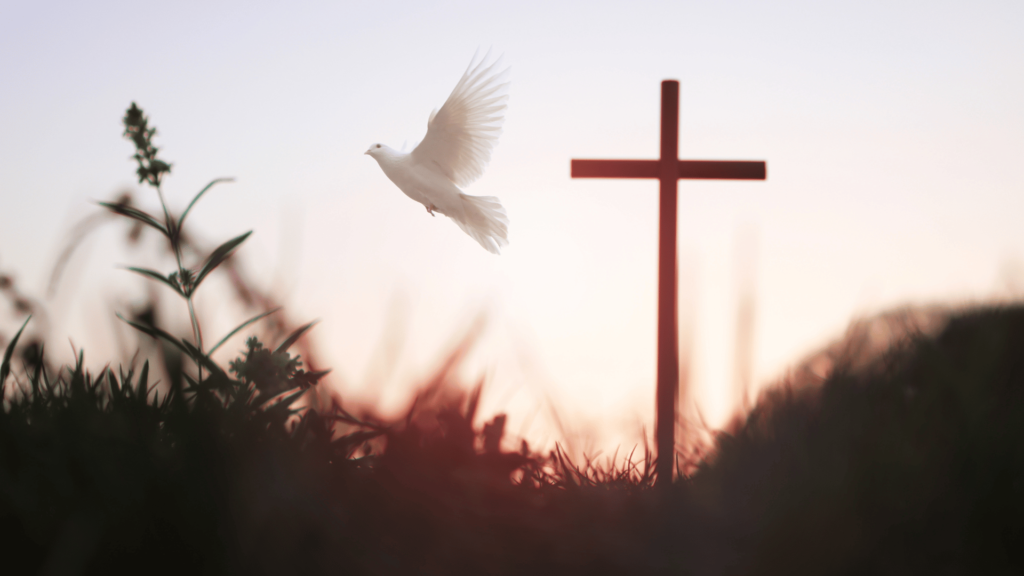
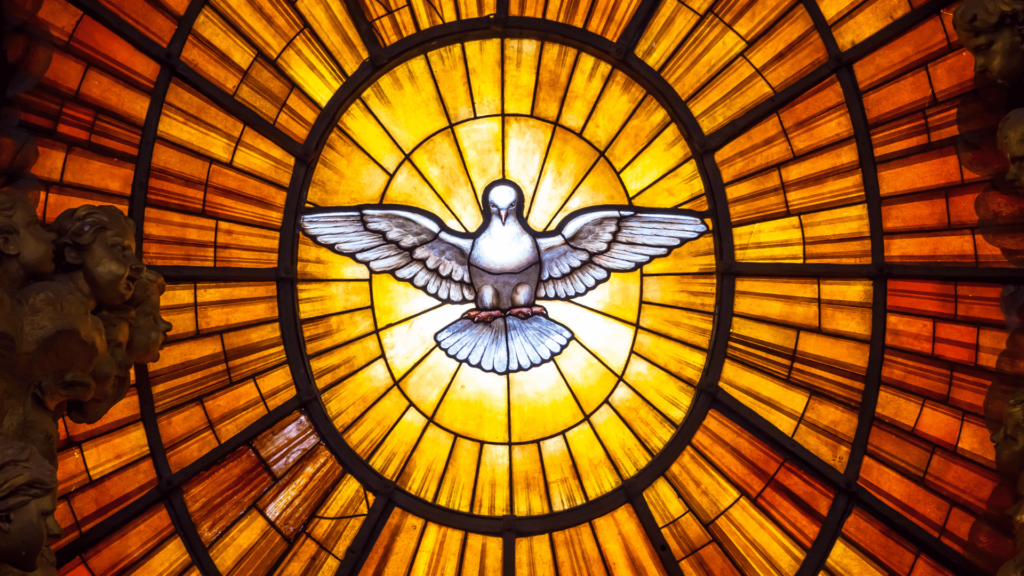
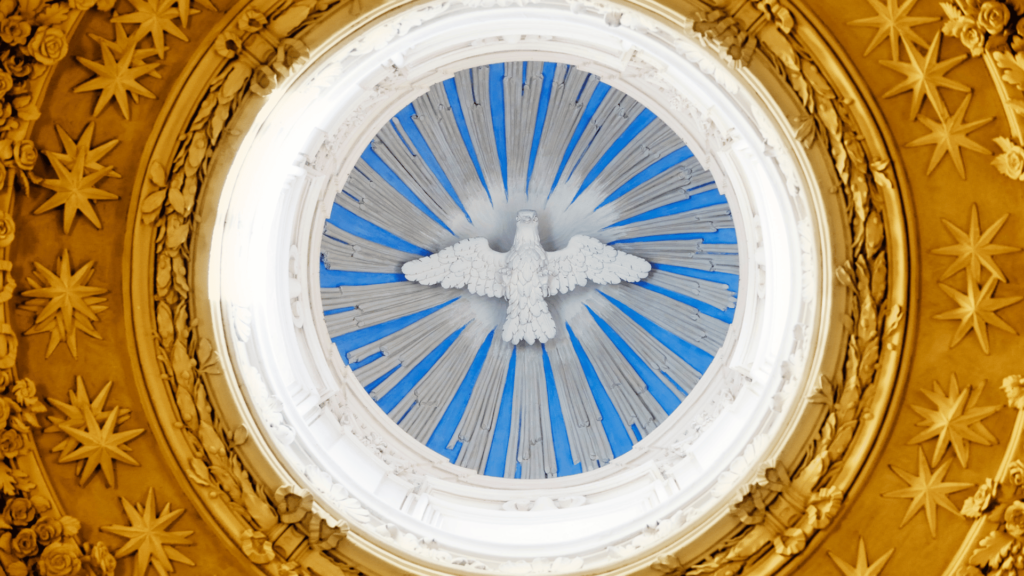
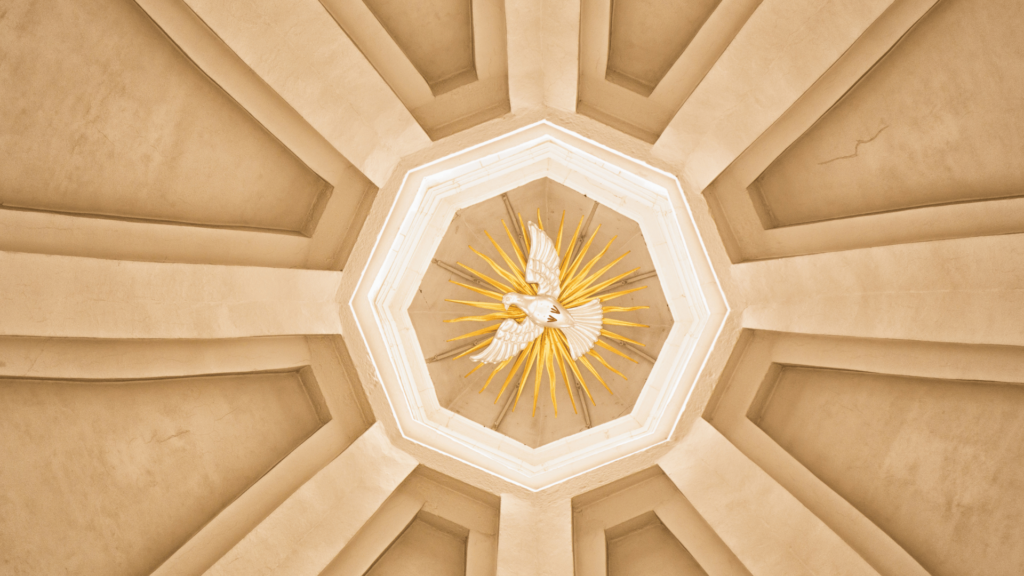
Biblical Significance
The appearance of the dove in the Bible signifies peace, purity, and divine guidance.
In the Old Testament, after the flood, Noah sent out a dove to find dry land, and it returned with an olive branch, symbolizing the end of God’s judgment and the beginning of a new covenant (Genesis 8:11).
This imagery carries through to the New Testament, where the dove signifies the peace and renewal brought by the Holy Spirit.
Theological Meaning
The Dove embodies the essence of the Holy Spirit’s role in the Trinity: the bringer of peace, the agent of purity, and the source of divine inspiration.
As the Holy Spirit descended upon Jesus, it signified the anointing and empowerment for His ministry.
This act underscores the dove’s role in conveying God’s presence and action in the world.
Symbol of Peace and Reconciliation
The Dove as a symbol of peace is deeply embedded in Christian thought and practice. It is often depicted with an olive branch, representing reconciliation and the end of conflict.
This symbolism invites believers to be peacemakers, following the example of Christ who, filled with the Holy Spirit, brought reconciliation between God and humanity.
Use in Christian Art and Liturgy
The Dove frequently appears in Christian art, particularly in depictions of the Holy Spirit.
It can be seen in stained glass windows, mosaics, and paintings, often in scenes of the Annunciation, the Baptism of Christ, and Pentecost.
In liturgy, the dove may be represented in church decorations and sacramental items, emphasizing the Holy Spirit’s presence in worship and the sacraments.
Personal Reflection and Devotion
For the individual believer, the Dove symbolizes the presence of the Holy Spirit in their life.
It is a reminder of the Spirit’s role in guiding, purifying, and empowering them to live out their faith.
The Dove encourages Christians to seek the peace of the Holy Spirit, to embrace purity in their actions, and to be open to divine inspiration.
Conclusion
The Dove is a profound symbol of the Holy Spirit’s presence and action within the Christian faith. It calls believers to embrace peace, purity, and divine guidance in their lives.
As St. Augustine beautifully said, “The Holy Spirit is love; whenever we feel love in our hearts, it is the Holy Spirit moving us.”
The Dove, as a representation of the Holy Spirit, invites us to live in the fullness of God’s love and to allow that love to guide our every step.
9. The Lamb
Symbol of Sacrifice and Redemption
The Lamb is a central and powerful symbol in Christianity, representing Jesus Christ as the sacrificial Lamb of God.
This symbolism is deeply rooted in both the Old and New Testaments, where the lamb signifies purity, sacrifice, and redemption.




Old Testament Foundations
In the Old Testament, the lamb is a prominent symbol in sacrificial rites. The Passover lamb, sacrificed by the Israelites in Egypt, is a profound example.
In Exodus 12:5-7, God instructs the Israelites to choose a lamb without blemish, sacrifice it, and mark their doorposts with its blood.
This act of faith spared them from the plague of the firstborn, symbolizing deliverance and God’s protection. The Passover lamb prefigures the ultimate sacrifice of Christ.
New Testament Fulfillment
In the New Testament, Jesus is identified as the Lamb of God by John the Baptist. In John 1:29, John declares, “Behold, the Lamb of God, who takes away the sin of the world!”
This proclamation links Jesus directly to the sacrificial lamb of the Old Testament, signifying that His death will bring ultimate redemption and deliverance from sin.
The Lamb in Revelation
The Book of Revelation richly portrays the Lamb. In Revelation 5:6-13, the Lamb is described as standing, though it appears to have been slain, symbolizing Jesus’s resurrection and victory over death.
The Lamb is worthy to open the scroll and receive honor and glory, signifying Jesus’s authority and kingship.
Revelation 7:17 further emphasizes, “For the Lamb at the center of the throne will be their shepherd; ‘he will lead them to springs of living water.’ ‘And God will wipe away every tear from their eyes.’“
Symbol of Purity and Innocence
The Lamb also represents purity and innocence. As described in 1 Peter 1:19, Jesus is a lamb “without blemish or defect.”
This purity is essential for the sacrificial role Jesus fulfills, making Him the perfect offering for the sins of humanity.
Use in Christian Art and Worship
The Lamb is a frequent motif in Christian art, especially in depictions of the Agnus Dei (Latin for “Lamb of God”).
It is often shown carrying a banner or standing on a book with seven seals, symbolizing Christ’s triumph and authority.
In worship, the Lamb is referenced in hymns, liturgies, and prayers, particularly during the Eucharist, where the sacrificial nature of Jesus’s death is commemorated.
Personal Reflection and Devotion
For the believer, the Lamb serves as a profound reminder of Jesus’s sacrifice and the redemption it brings.
It invites Christians to reflect on the immense love and mercy that led Jesus to lay down His life.
The Lamb encourages believers to live in gratitude for this sacrifice and to strive for purity and righteousness in their own lives.
Conclusion
The Lamb is a deeply scriptural and theological symbol that encapsulates the essence of Jesus’s sacrifice and the redemption of humanity.
It calls believers to remember and celebrate the profound act of love that is at the heart of the Christian faith.
As Revelation 7:10 declares, “Salvation belongs to our God, who sits on the throne, and to the Lamb.”
The Lamb stands as a testament to the enduring love and mercy of Jesus Christ.
10. The Sacred Monogram (IHS)
Ancient Christogram
The Sacred Monogram, often represented by the letters IHS, is an ancient and revered symbol in Christianity.
These letters are a Christogram, a combination of letters that forms an abbreviation for the name of Jesus Christ in Greek.
The monogram is derived from the first three letters of Jesus’s name in Greek, ΙΗΣΟΥΣ (Iēsous).
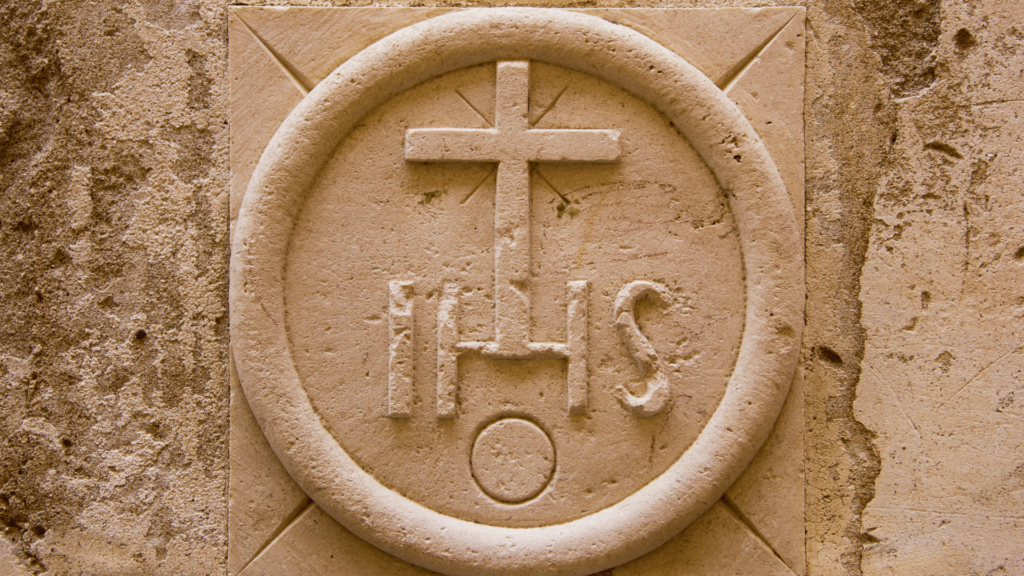
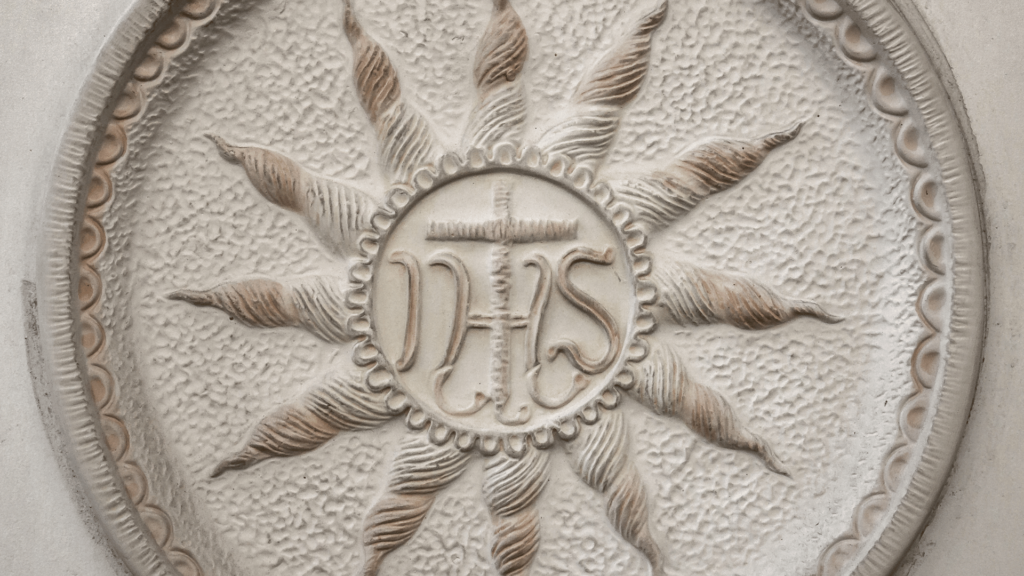

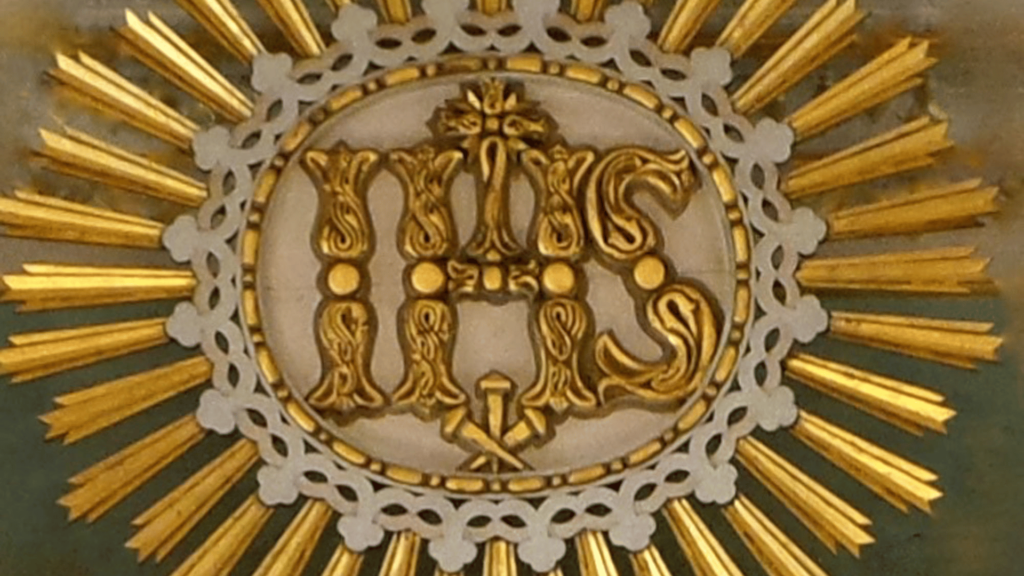
Scriptural and Historical Roots
The use of the IHS monogram can be traced back to early Christianity, where it served as a shorthand for Jesus’s name.
This practice aligns with the reverence for the name of Jesus seen throughout the New Testament.
Philippians 2:9-11 emphasizes this reverence: “Therefore God exalted him to the highest place and gave him the name that is above every name, that at the name of Jesus every knee should bow, in heaven and on earth and under the earth, and every tongue acknowledge that Jesus Christ is Lord, to the glory of God the Father.“
Symbol of Jesus’s Presence
The IHS monogram symbolizes the presence and centrality of Jesus in the life of believers and the Church.
It is often used to mark items dedicated to Christ, reminding the faithful of His divine presence and authority.
This simple yet profound symbol serves as a constant reminder of the holy name and the power it holds.
Use in Christian Art and Liturgy
The Sacred Monogram appears frequently in Christian art, liturgical items, and church architecture.
It can be seen on altars, vestments, and sacred vessels, signifying their dedication to Christ.
The IHS is also commonly embroidered on liturgical garments, etched into church furnishings, and inscribed on the front of altars and pulpits.
Significance in Devotional Practices
In devotional practices, the IHS monogram encourages a deeper reverence for the name of Jesus.
It is often included in prayers, hymns, and meditations, helping believers to focus on the holy name.
This reverence is rooted in passages like Acts 4:12, which states, “Salvation is found in no one else, for there is no other name under heaven given to mankind by which we must be saved.“
The Jesuit Connection
The IHS symbol gained further prominence through its adoption by the Society of Jesus (Jesuits), founded by St. Ignatius of Loyola.
The Jesuit emblem prominently features the IHS monogram, surrounded by rays of light and often with a cross above and three nails below.
This emblem underscores the Jesuits’ mission to glorify the name of Jesus through education, missionary work, and spiritual exercises.
Personal Reflection and Reverence
For the individual believer, the IHS monogram serves as a reminder of the power and sanctity of Jesus’s name.
It encourages Christians to call upon Jesus in prayer, trust in His saving power, and live in a way that honors His name.
Reflecting on the IHS can deepen one’s appreciation for the gift of salvation and the ongoing presence of Christ in their life.
Conclusion
The Sacred Monogram (IHS) is a timeless symbol that encapsulates the reverence and love Christians have for the name of Jesus.
It serves as a constant reminder of His presence, power, and the salvation He offers.
As Acts 4:12 reminds us, “Salvation is found in no one else, for there is no other name under heaven given to mankind by which we must be saved.”
The IHS monogram continues to inspire devotion and reverence for the holy name of Jesus Christ.
11. The Fleur-de-lis

The Fleur-de-lis is a stylized lily flower that holds significant symbolic meaning in Christianity, particularly within the Catholic tradition.
It represents purity and the Virgin Mary, often associated with her immaculate conception and perpetual virginity.
The Fleur-de-lis is commonly seen in church architecture, heraldry, and religious art, serving as a reminder of Mary’s role as the pure and holy Mother of God. Learn more about the Fleur-de-lis.
12. The Keys of Heaven

The Keys of Heaven symbolize the authority given by Jesus to St. Peter, and by extension, to his successors, the popes.
This symbol is derived from Matthew 16:19, where Jesus says to Peter, “I will give you the keys of the kingdom of heaven.”
The crossed keys are often depicted in papal insignia and Vatican emblems, representing the power to bind and loose on earth and in heaven. Explore more about the Keys of Heaven.
13. The Trinity (Triangle)
The Triangle is a symbol of the Holy Trinity, representing the Father, Son, and Holy Spirit.
An equilateral triangle is often used to illustrate the co-equal and co-eternal nature of the three Persons of the Trinity.
This symbol can be found in church decorations, liturgical art, and theological texts, helping believers contemplate the mystery of the Triune God. Discover more about the Holy Trinity.
14. The Pelican
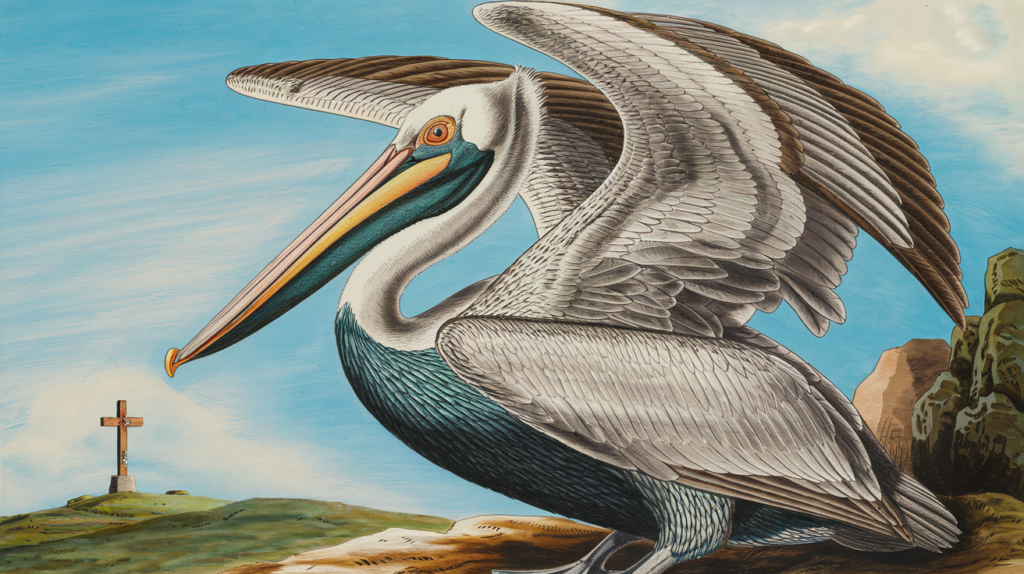
The Pelican is a lesser-known but deeply symbolic Christian icon. It represents Christ’s sacrifice and the Eucharist.
According to legend, a pelican would pierce its own breast to feed its young with its blood, symbolizing Jesus’s sacrificial love and the shedding of His blood for humanity.
This imagery is often found in medieval church art and stained glass windows. Learn more about the Pelican symbolism.
15. The Anchor

The Anchor is a symbol of hope and steadfast faith in Christianity. It is derived from Hebrews 6:19, which describes hope as “an anchor for the soul, firm and secure.”
The anchor represents the stability and security found in Christ, especially during times of trial and persecution.
Early Christians used the anchor as a covert symbol of their faith. Read more about the Anchor symbol.
16. The Lily
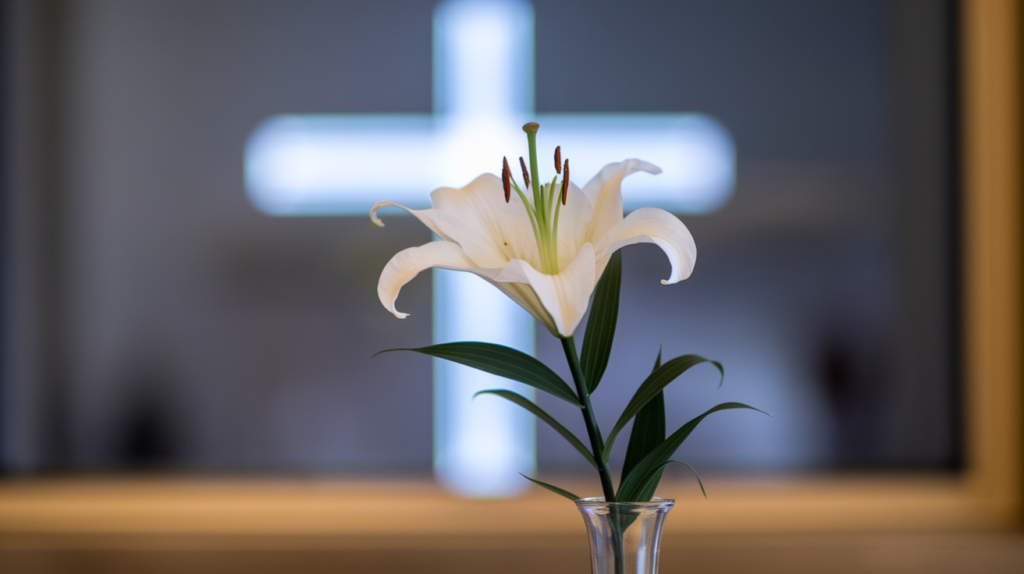
The Lily is a symbol of purity and resurrection, often associated with the Virgin Mary and Easter.
The white lily, or Madonna lily, signifies Mary’s purity and her role as the mother of Jesus.
During Easter, lilies are used to represent the resurrection of Christ and the promise of eternal life.
This flower is a common motif in religious art and church decorations. Explore more about the Lily.
17. The Crown of Thorns
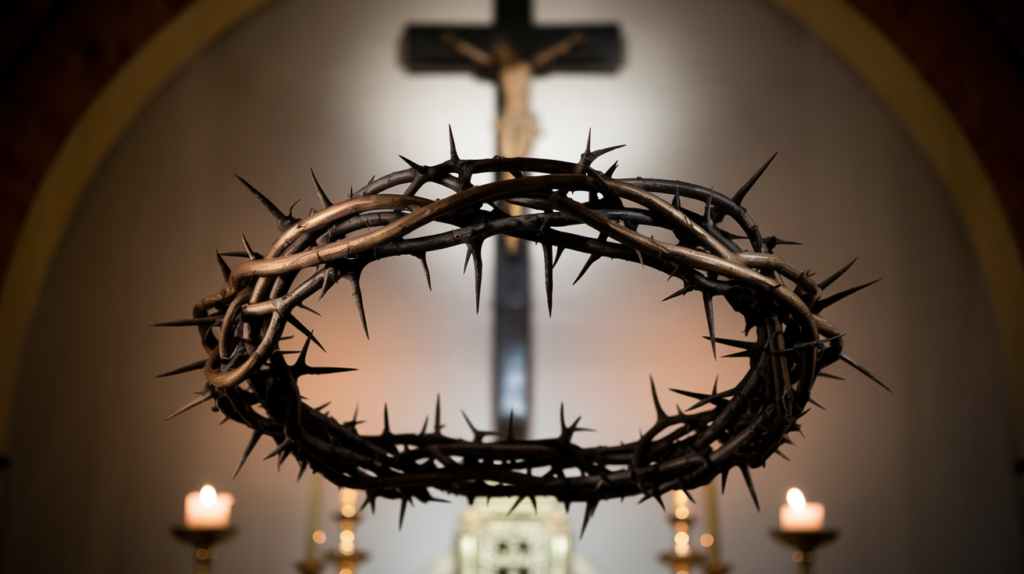
The Crown of Thorns symbolizes the suffering and sacrifice of Jesus Christ.
It was placed on Jesus’s head during His Passion, mocking His claim to kingship.
This symbol represents the pain and humiliation endured by Christ for the salvation of humanity.
It serves as a powerful reminder of His love and sacrifice, particularly during Lent and Holy Week. Learn more about the Crown of Thorns.
18. The Pomegranate

The Pomegranate is a symbol of resurrection and eternal life in Christian art.
Its many seeds represent the Church’s unity and the multitude of believers.
The pomegranate’s bursting open signifies the fullness of Christ’s passion and the promise of eternal life.
This fruit is often depicted in religious paintings, sculptures, and tapestries. Discover more about the Pomegranate.
19. The Phoenix
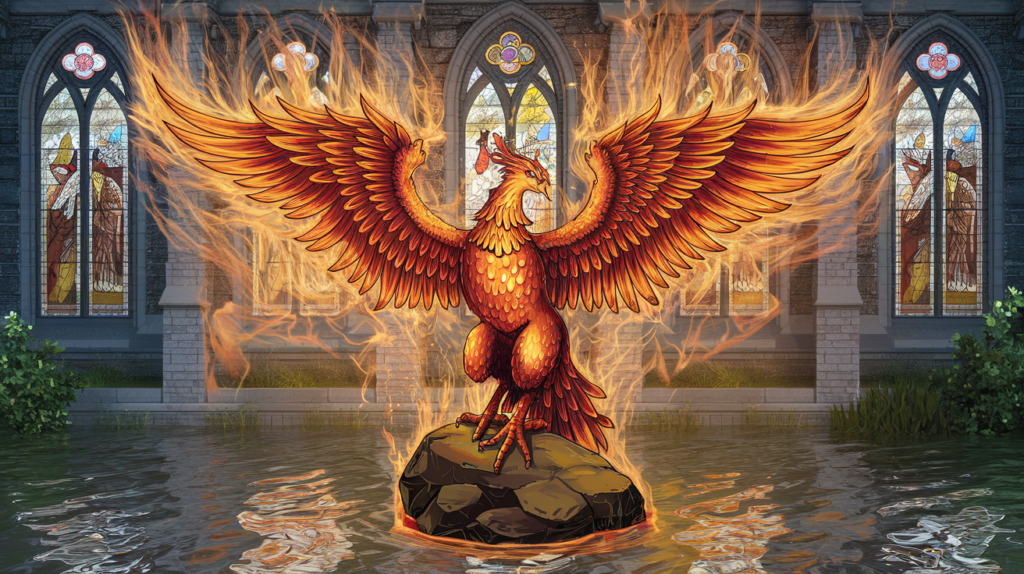
The Phoenix is a mythical bird that symbolizes resurrection and immortality.
According to legend, the phoenix burns itself to ashes and rises anew from the fire.
This imagery is used in Christianity to represent Christ’s resurrection and the promise of eternal life for believers.
The phoenix appears in early Christian art and literature as a symbol of hope and renewal. Read more about the Phoenix.
20. The Shell

The Shell is a significant symbol in Christianity, particularly associated with baptism. It represents the sacrament of baptism, new life, and spiritual cleansing.
The shell is often depicted with water droplets, symbolizing the washing away of sin and the initiation into the Christian faith.
This symbol is commonly seen in baptismal fonts, religious art, and is sometimes used in the actual administration of the sacrament. Learn more about the Shell.
21. The Ark

The Ark is a potent symbol in Christianity, representing salvation and God’s covenant with humanity.
It is most famously associated with Noah’s Ark from the Old Testament, where Noah builds an ark to save his family and animals from the Great Flood (Genesis 6-9).
This story symbolizes God’s mercy, protection, and the promise of salvation for the faithful.
In the New Testament, the Ark can also represent the Church as the vessel of salvation, guiding believers through the turbulent waters of life. Learn more about the Ark.
22. The Vine
The Vine is a symbol of Jesus Christ and His followers, often used to represent the close relationship between Christ and His disciples.
In John 15:5, Jesus says, “I am the vine; you are the branches. If you remain in me and I in you, you will bear much fruit; apart from me you can do nothing.”
This imagery emphasizes the importance of remaining connected to Christ to bear spiritual fruit and live a life that glorifies God.
The vine is frequently depicted in Christian art and serves as a reminder of the nurturing and sustaining power of Jesus. Learn more about the Vine.


